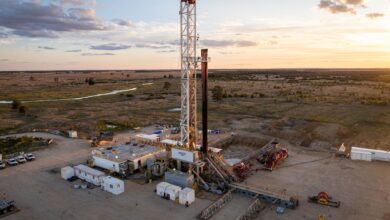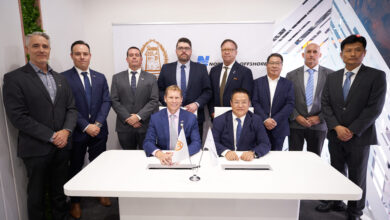Shape memory polymer sand control system morphs to fill annular space

Baker Hughes’ new GeoFORM sand management system, commercially launched this month, is being referred to as “sand control on a stick,” according to Eddie Bowen, GeoFORM product manager for Baker Hughes. The description is based on how the technology is delivered into the borehole.
A departure from conventional forms of sand control, such as gravel packs and screens, the new system consists of a shape memory polymer that is manufactured to a desired shape and size, placed on the outside of base pipe and then compacted to a smaller shape to allow it to be run in hole.
“It’s a time of epic proportions for sand control,” Mr Bowen said, adding that the industry toolbox is full of sand control solutions that have had only marginal success. “The shape memory polymer technology gives the benefit of a full annular pack, filling irregularities downhole.”
The main application of the shape memory polymer is open-hole long horizontal wells, although there is also limited application in cased-hole wells. Additionally, there is an application for the system in remediation. “There’s a lot of failed sand control out there,” Mr Bowen said. Using slim-hole, coiled-tubing or wireline techniques, the system can be deployed across the production interval to repair sanding problems through an existing completion.
When exposed to bottomhole temperatures and a catalyst, the shape memory polymer material expands to its original shape to fully contact the borehole wall, conform to abnormalities and provide a positive stress on the formation. The ability of this system to conform to abnormalities and provide a residual borehole strain is designed to offer superior protection, according to Mr Bowen, and to reduce the likelihood of plugging or loss of sand control due to compaction.
The polymer, which is activated by the glass transition temperature, is provided in modular, 6-ft increments, allowing integration with inflow control devices and zonal isolation technology. This modularity also means the screen can be assembled in the country in which the project is to take place and allows customization through the use of local personnel and materials.
“We believe that the GeoFORM system is a revolutionary technology that can deliver a step-change in reliable performance for our offshore and deepwater markets,” Derek Mathieson, president of products and technology for Baker Hughes, said. “We developed the ‘smart’ materials used in the shape memory polymer while researching designer materials, and particularly how those materials from other scientific disciplines can be applied or modified for hydrocarbon exploration and production.”
The open-cell shape memory polymer system was first used on a well in the Adriatic Sea in December 2010. The target zone was located below several other planned production intervals in a tight, highly unconsolidated, laminated, silt and shale reservoir with close water contact, not allowing for a frac pack completion. The new system was installed using gravel-pack running tools. After the production packer was set, the activation fluid was spotted to initiate deployment of the shape memory polymer to the borehole.
Following installation of the upper completion zones, a cleanup run was made with coiled tubing. To clean up any residual filter cake, a 12-bbl, 7.5% HCl acid pill was pumped with coiled tubing; however, no improvement in production was recorded, indicating that the filter cake flowback was successful before pumping the acid. Production steadied out during the production test, further indicating that the shape memory polymer system assembly was providing sand control without plugging in this very non-uniform shale environment.




